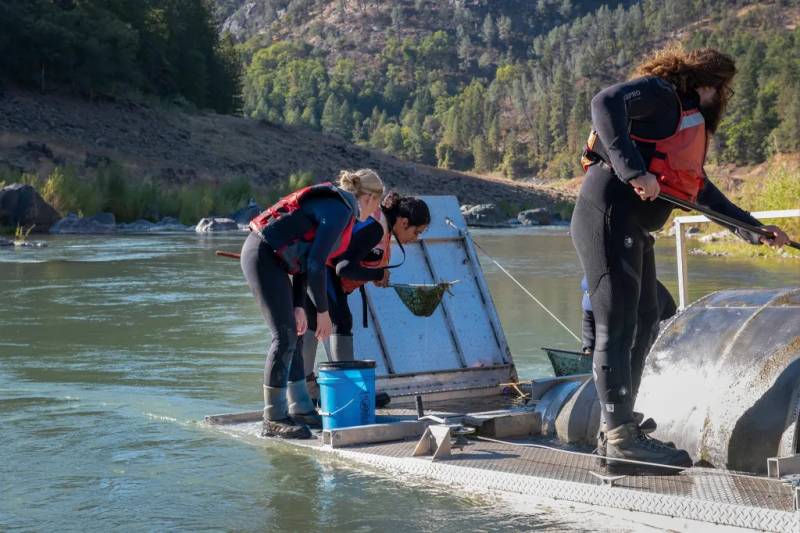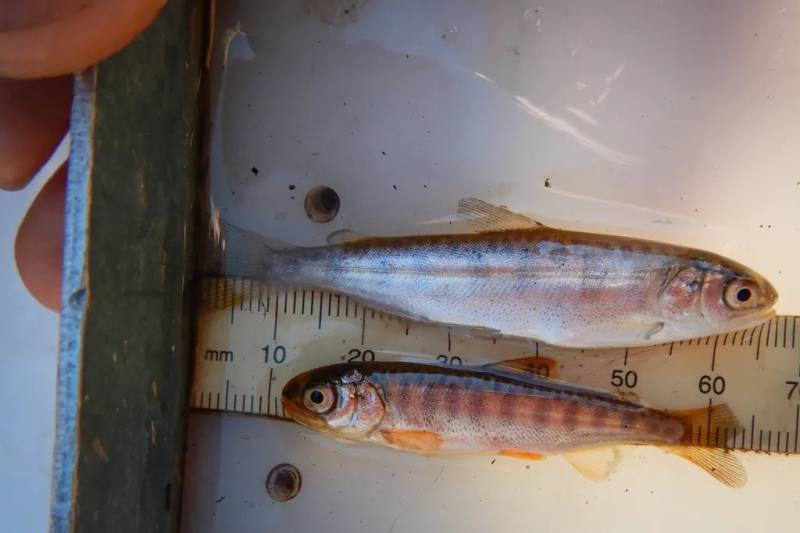Even though the Central Valley’s river system, which includes the McCloud River, marks the southern limit of the Chinook’s range, it was once their stronghold. Between 1 and 2 million fish, some weighing 50 pounds or more, spawned in the tributaries of the Sacramento and San Joaquin rivers each year before the Gold Rush.
The fish have dwindled to a fraction of their historic abundance. Spawning numbers of winter-run Chinook dropped to fewer than 200 in the early 1990s. They’ve rebounded, but their future remains in doubt.
The McCloud — a state-designated wild and scenic river — used to offer prime habitat, with deep gravel beds for egg-laying and year-round flows of clean, cold water from Mount Shasta. Construction of Shasta Dam in the 1940s — and Keswick Dam shortly after — changed all this by locking ocean-run salmon out of some 500 miles of productive high-elevation habitat.
The salmon became confined instead to the lower reaches of the Sacramento River system, where they did not previously spawn. Blazing temperatures in the summer — when the winter-run fish lay and fertilize their eggs near Redding and Red Bluff — have made it difficult for salmon to thrive. Chinook, especially in their early life stages, are sensitive to high temperatures.
Only with the support of hatcheries have California salmon remained abundant enough to be fished.
River habitat for winter-run Chinook salmon has shrunk
Juvenile Chinook salmon born in the McCloud River once migrated downstream, into the Sacramento River and out to the Pacific Ocean. Today, about 80% of the salmon’s historical river habitat is behind dams, which prevents the adult fish from swimming upstream to spawn. The state is mounting an experiment to return them to the McCloud River.
 Map of river habitat for winter-run Chinook salmon. (NOAA)
Map of river habitat for winter-run Chinook salmon. (NOAA)
For decades, fishing groups, agencies and Winnemem Wintu tribal leaders have pondered the possibility of reintroducing salmon into the McCloud. Finally, last spring and summer, after two poor spawning years in a row — and with a third one looking likely — federal and state agencies took action.
Last year “temperature modeling going into the winter-run spawning season showed a lot of uncertainty — basically a 50-50 chance of being able to maintain suitable temperatures for winter-run eggs to develop in the river,” said Johnson of the Department of Fish and Wildlife.
A bumpy trip for precious salmon eggs
Because winter-run Chinook are listed as endangered, fishery agencies are scrambling to save the fish. Last spring they transported about three dozen adult winter-run Chinook trapped at the base of Keswick Dam, just north of Redding, about 50 miles southeast to the north fork of Battle Creek, a tributary near Red Bluff where waters typically run cool and clear.
They also launched a more complicated effort: They took winter-run Chinook eggs from adult fish at a federal salmon hatchery and transported them up and over Shasta Dam to a remote national forest campground next to the McCloud River.
They came in two batches of 20,000 — the first by truck on a bumpy, 80-mile ride. A helicopter delivered the second clutch. “We wanted to make sure the transportation phase went smoothly,” Johnson said.
The fertilized eggs were incubated in protective cages submerged in river water for weeks. The scientists even placed an electrified barrier around the eggs to protect them from foraging black bears.
 Rachel Johnson of NOAA Fisheries and state biologists Sam Funakoshi and Ross Schaefer check a trap for winter-run Chinook salmon that will be transported downstream of Keswick Dam to help them migrate to the ocean. (Carson Jeffres/UC Davis)
Rachel Johnson of NOAA Fisheries and state biologists Sam Funakoshi and Ross Schaefer check a trap for winter-run Chinook salmon that will be transported downstream of Keswick Dam to help them migrate to the ocean. (Carson Jeffres/UC Davis)
Of the 40,000 eggs, Johnson said, about 36,000 emerged as fry. In late summer, the biologists released them into the wild.
The scientists wanted the fish to spend time in McCloud, both to utilize its invertebrate food sources and to undergo the olfactory imprinting process that enables migrating adult salmon to find their birth streams years later. Indeed, it is this process that gives salmon their remarkable homing powers and would truly make these fish McCloud River salmon.
In an undisturbed ecosystem, the fish in the river would simply swim downstream, through San Francisco Bay, and out into the ocean. But this unique scenario, where a dam and reservoir block their migration, called on a different approach that required human help.
State and federal scientists had to recapture the salmon and release them into the lower Sacramento River. The Fish and Wildlife team placed several traps on the McCloud about 20 miles below the release site and managed to capture 1,600 of them. They then drove the fish downstream and released them into the Sacramento River. If all goes well, some of the young salmon will return from the ocean in two to four years.
The agencies plan to repeat the project next year, transporting more Chinook eggs up to the McCloud and again hauling the young fish back downstream. “We intend to do it again, and do it better,” Johnson said.
To improve the program’s effectiveness, scientists are now addressing some unanswered questions from the experiment.
Rachel Johnson, a biologist with the National Oceanic and Atmospheric Administration’s Southwest Fisheries Science Center, wants to know how many of the salmon released at the incubation site made it as far downstream as the fish trap array. This will reveal the survival rate of the released fish and help Johnson and her colleagues better understand the quality of the McCloud’s habitat.
To do this, she is studying data on daily river flow rates and capture rates in the traps, then combining this information with the known effectiveness of the types of gear they used. That, she said, would “give us the number that swam past.”
From what they already know about the size of the fish upon recapture, it’s looking good.
“The fish in the McCloud were 30 to 40% larger than the average winter-run fish that were being caught at the Red Bluff Diversion Dam,” she said, referring to a structure downstream of Shasta.
A gem in ‘a string of pearls’
A great deal of work has already been done to help Sacramento River salmon. State agencies and conservation groups have restored floodplains and side channels, where slow-moving water provides young fish with abundant food and shelter from predators. This work often involves removing, or carving notches in, levees so that river water can flow over farm fields.
Johnson sees this connected system of restored habitat parcels as a “string of pearls,” and says the McCloud might be one of its more valuable gems.
Better still, the McCloud’s geographic location at the upper end of the watershed could have a beneficial trickle-down effect through the watershed and the early life stages of Chinook, ultimately improving their lifelong survival rates.
“If you can have such highly productive, good-growth habitat so high in the system, it starts the fish off in such a strong condition,” she said.
Protecting areas lower in the watershed are important to Chinook, too. Research by Jacob Katz, biologist with the group California Trout, shows that floodplains restored in the lower stretches of the Sacramento watershed have helped salmon. Smolts grow faster on inundated floodplains than they do in the river’s channelized main stem.
Katz said reintroducing Chinook to the high-elevation spawning areas in the McCloud will complement the work he has done, and vice versa.
“Both spawning habitat and rearing habitat are necessary, yet insufficient on their own,” he said. “We need to restore every link in the habitat chain.”
Ambitious future plans
The summer’s salmon relocation effort was technically not a reintroduction project but an emergency drought action required by the state and federal endangered species acts and intended to shield winter-run Chinook from drought impacts.
However, it’s likely that the McCloud effort of last summer will develop in years ahead into a full-fledged salmon reintroduction program.
Randy Beckwith, head of the state Department of Water Resources’ Riverine Stewardship branch, said “the juvenile collection piece is the most difficult part” of a potential long-term McCloud River reintroduction plan.
 Marine Sisk, biologist with the Winnemem Wintu Tribe, measures a juvenile winter-run Chinook salmon reared in the McCloud (top) compared to a much smaller similar-age fish reared in the hatchery. (Eric Holmes/UC Davis)
Marine Sisk, biologist with the Winnemem Wintu Tribe, measures a juvenile winter-run Chinook salmon reared in the McCloud (top) compared to a much smaller similar-age fish reared in the hatchery. (Eric Holmes/UC Davis)
While the state and federal fishery scientists did their work a few miles upstream, Beckwith’s agency tested a $1.5 million contraption dubbed the Juvenile Salmonid Collection System in the narrow McCloud River arm of Lake Shasta. The setup is a floating array designed to deflect floating debris, like logs and trash, while a dangling synthetic curtain funnels the young salmon into a dead-end live trap. The trap component has not been installed yet due to regulatory constraints associated with handling endangered species, but the agency has plans to do so, possibly next summer.
While traps of the sort already used on the McCloud are designed to catch a sample fraction of a river’s fish, the system the state is working on will hopefully catch all of them.
A successful McCloud River salmon reintroduction would also mean giving adult salmon access to the river. Currently, Keswick Dam, just upstream of Redding, marks the end of the line for free-swimming adult salmon. If they are to get beyond this point, fishery managers will need to do one of two things: build a stairway, called a fish ladder or fishway, which leads migrating salmon around a dam, or trap the fish and truck them upstream.
Ladders would give the salmon autonomy to migrate on their own. But Shasta Dam is a 600-foot-high barrier, so hauling them instead would be much cheaper. It is generally considered the only feasible solution on the table, although federal officials have no firm plans to do so yet.
But scientists have questioned the effectiveness of trap-and-haul programs. In a 2017 paper, Moyle and a colleague, biologist Robert Lusardi, warned that it can cause high mortality rates in transferred fish, both adults going upstream and juveniles coming downstream. A trap-and-haul program for salmon “should proceed with extreme caution,” they wrote.
There’s another option, too. Battle Creek, which flows off Mount Lassen’s south flank, could also serve as a lifeline for winter-run Chinook. It was once an important spawning stream and, like most California rivers, is now riddled with dams.
But unlike Keswick and Shasta, they are small. One dam was removed in 2010, and Katz said there are plans to remove or modify the rest to provide Chinook with unassisted passage.




















